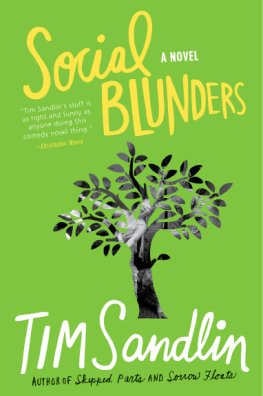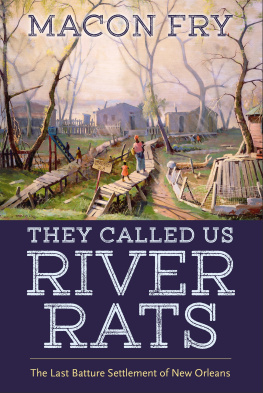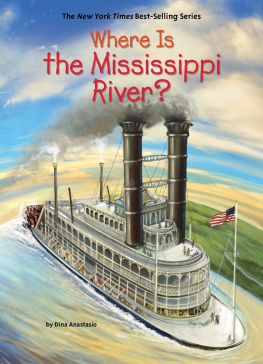Lee Sandlin - Wicked River: The Mississippi When It Last Ran Wild
Here you can read online Lee Sandlin - Wicked River: The Mississippi When It Last Ran Wild full text of the book (entire story) in english for free. Download pdf and epub, get meaning, cover and reviews about this ebook. year: 2010, publisher: Pantheon, genre: Art. Description of the work, (preface) as well as reviews are available. Best literature library LitArk.com created for fans of good reading and offers a wide selection of genres:
Romance novel
Science fiction
Adventure
Detective
Science
History
Home and family
Prose
Art
Politics
Computer
Non-fiction
Religion
Business
Children
Humor
Choose a favorite category and find really read worthwhile books. Enjoy immersion in the world of imagination, feel the emotions of the characters or learn something new for yourself, make an fascinating discovery.

- Book:Wicked River: The Mississippi When It Last Ran Wild
- Author:
- Publisher:Pantheon
- Genre:
- Year:2010
- Rating:3 / 5
- Favourites:Add to favourites
- Your mark:
- 60
- 1
- 2
- 3
- 4
- 5
Wicked River: The Mississippi When It Last Ran Wild: summary, description and annotation
We offer to read an annotation, description, summary or preface (depends on what the author of the book "Wicked River: The Mississippi When It Last Ran Wild" wrote himself). If you haven't found the necessary information about the book — write in the comments, we will try to find it.
Lee Sandlin: author's other books
Who wrote Wicked River: The Mississippi When It Last Ran Wild? Find out the surname, the name of the author of the book and a list of all author's works by series.
Wicked River: The Mississippi When It Last Ran Wild — read online for free the complete book (whole text) full work
Below is the text of the book, divided by pages. System saving the place of the last page read, allows you to conveniently read the book "Wicked River: The Mississippi When It Last Ran Wild" online for free, without having to search again every time where you left off. Put a bookmark, and you can go to the page where you finished reading at any time.
Font size:
Interval:
Bookmark:
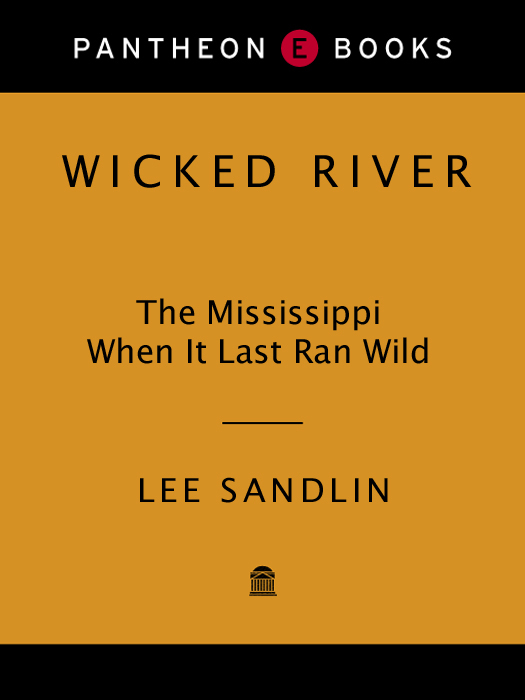
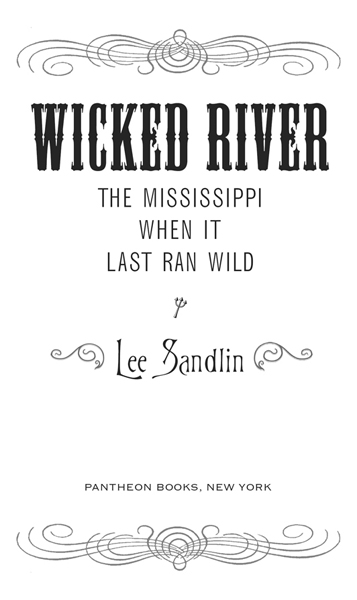
Copyright 2010 by Lee Sandlin
All rights reserved. Published in the United States by Pantheon Books, a division of Random House, Inc., New York, and in Canada by Random House of Canada Limited, Toronto.
Pantheon Books and colophon are registered trademarks of Random House, Inc.
Images from the Davy Crockett Almanacs are reproduced courtesy of Dorothy Sloan Rare Books. The Ribbon Map of the Great Mississippi River is from the Library of Congress.
Library of Congress Cataloging-in-Publication Data
Sandlin, Lee.
Wicked river : the Mississippi when it last ran wild / Lee Sandlin.
p. cm.
eISBN: 978-0-307-37951-1
1. Mississippi RiverHistory19th century. 2. Mississippi RiverGeography. 3. Mississippi RiverEnvironmental conditions. 4. River lifeMississippi River RegionHistory19th century. 5. Community lifeMississippi River RegionHistory19th century. 6. Mississippi River RegionHistory19th century. 7. Mississippi River RegionBiography. 8. Mississippi River RegionSocial life and customs19th century. 9. Social changeMississippi River RegionHistory19th century. 10. DisastersMississippi River RegionHistory19th century. I. Title.
F353.S26 2010 977dc22 2010008511
www.pantheonbooks.com
v3.1
FOR JOANNE FOX
SINE QUA NON
For if and when we talk of a river we talk of a deep and dank architecture.
Harold Pinter, No Mans Land
I do not remember to have traversed this river in any considerable trip, without having heard of some fatal disaster to a boat, or having seen a dead body of some boatman, recognised by the red flannel shirt, which they generally wear. The multitudes of carcasses of boats, lying at the points, or thrown up high and dry on the wreck-heaps, demonstrate most palpably, how many boats are lost on this wild, and, as the boatmen always denominate it, wicked river.
Timothy Flint, Recollections
I hate the Mississippi, and as I look down upon its wild and filthy waters, boiling and eddying, and reflect how uncertain is travelling in this region I cannot help feeling a disgust at the idea of perishing in such a vile sewer, to be buried in mud, and perhaps to be rooted out again by some pig-nosed alligator.
Frederick Marryat, A Diary in America
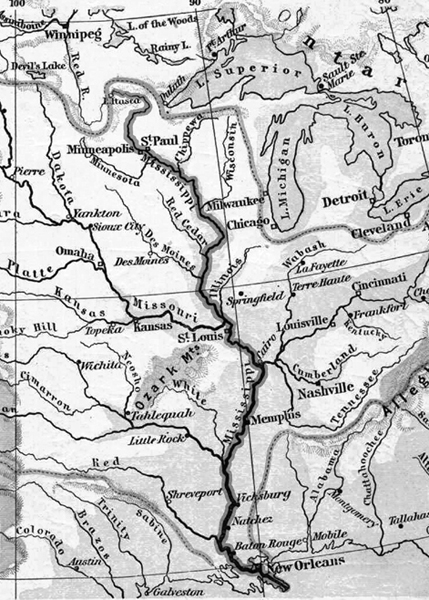
The path of the Mississippi River, from its source at Lake Itasca to the Gulf of Mexico
THERE IS A TRIBUTARY of the Mississippi River running through my neighborhood in Chicago. Its not easy to spot; you have to know just where to look. Its by the bus stop on a cluttered commercial block. Right at the curb is a manhole. The manhole cover is embossed with a decorative pattern of fish, and it carries the message DUMP NO WASTE! DRAINS TO WATERWAYS! Down below is water bound for the Mississippi.
Sometimes when Im waiting for the bus, I pass the time by imagining the course the water is running. Its invisible at street level, but there is a maze of piping underneath Chicago: water mains and sewer mains and gas mains, electrical conduit and fiber-optic cabling. The water is gurgling through this spaghetti tangle for mile after mile, below the ranges of highrises and the decaying industrial districts and the limitless veldts of bungalows. It doesnt surface until it reaches a pumping station past the southern city limits. There it empties into the Illinois River. The Illinois runs in a meandering course roughly southwest, past the suburban counties around Chicago, out through the exurban fringe, then south through the farm country in the middle of the state, and then west again, until at last, just north of St. Louis, it drains into the Mississippi.

This is a serpentine route, but its not an unusual one. There are countless streams just like it. In the nineteenth century, it was estimated that the Mississippi had roughly one hundred thousand natural tributariesthat is, there were a hundred thousand distinct, individually named brooks, creeks, rivulets, and rivers emptying their waters into its gargantuan current. Today there are far more than a hundred thousand, and the majority of them are artificial. Theyre like the manhole by the bus stop: theyre conduits and cisterns and sewage pipes, obscure canals and neglected culverts and out-of-the-way storm drains. The Mississippi is surrounded by a vast network of concealed plumbing that underlies the whole of the American Midwest.
As for the great river at the heart of this maze, it is now for all intents and purposes a man-made artifact. Every inch of its course from its headwaters to its delta is regulated by synthetic meansby locks and dams and artificial lakes, revetments and spillways and control structures, chevrons and wing dams and bendway weirs. The resulting edifice can barely be called a river at all, in any traditional sense. The Mississippi has been dredged, and walled in, and reshaped, and fixed; it has been turned into a gigantic navigation canal, or the worlds largest industrial sewer. It hasnt run wild as a river does in nature for more than a hundred years.
Its waters are notoriously foul. In the nineteenth century, the Mississippi was well known for its murkiness and filth, but today it swirls with all the effluvia of the modern age. Theres the storm runoff, thick with the glistening sheen of automotive waste. The drainage from the enormous mechanized farms of the heartland, and from millions of suburban lawns, is rich with pesticides and fertilizers like atrazine, alachlor, cyanazine, and metolachlor. A ceaseless drizzle comes from the chemical plants along the riverbanks that manufacture neoprene, polychloroprene, and an assortment of other refrigerants and performance elastomers. And then there are the waste products of steel mills, of sulfuric acid regeneration facilities, and of the refineries that produce gasoline, fuel oil, asphalt, propane, propylene, isobutane, kerosene, and coke. The Mississippi is one of the busiest industrial corridors in the world.

I get a little reminder of the health of this system every time I pass by that bus stop. Theres a reason why the one particular manhole stands out among all the clutter of ancient grilles and grates along the block. It reeks. Winter and summer, it emits a peculiar odor, a compound of sewer gas, stale grease, and some kind of pungent chemical reminiscent of sour mint. I can tell how bad it is on any given day by the behavior of the people waiting at the curb. Sometimes they have to hang so far back that the bus blows past the corner without a pause.
Of course it seems all wrong to think of the Mississippi River this way, as an industrial drainage system the length of a continent. Its not how we want to picture Old Man Riverthe river of the paddle-wheel steamboats, the river that Huck and Jim escaped down when they rode their raft to freedom. That river, we like to imagine, is still running wild the way it always was. The wistful old song Moon River, popular back in the sixties, caught the feeling perfectly:
Font size:
Interval:
Bookmark:
Similar books «Wicked River: The Mississippi When It Last Ran Wild»
Look at similar books to Wicked River: The Mississippi When It Last Ran Wild. We have selected literature similar in name and meaning in the hope of providing readers with more options to find new, interesting, not yet read works.
Discussion, reviews of the book Wicked River: The Mississippi When It Last Ran Wild and just readers' own opinions. Leave your comments, write what you think about the work, its meaning or the main characters. Specify what exactly you liked and what you didn't like, and why you think so.

